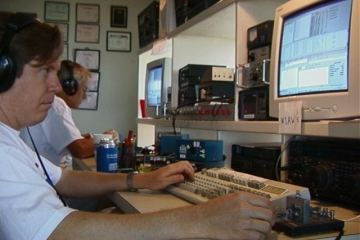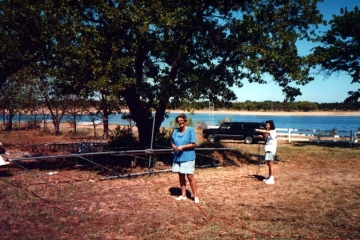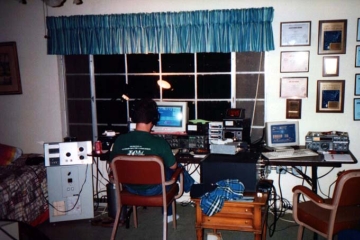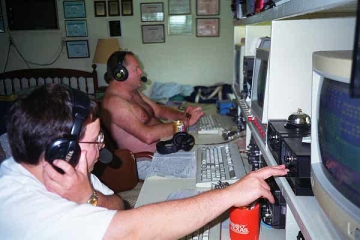Results
Contacts
A Short History of the W5KFT Ranch Station
The Vision
When Bryan Edwards W5KFT decided to build a competitive DXing and contest station in the Texas Hill Country, he sought the advice and help of George Fremin III WB5VZL (now K5TR). As George recalls, "In the fall of 1992, I got a phone call from Bryan Edwards W5KFT. Bryan was looking for someone to help him design and build a DX/contest station at his family ranch in the Texas Hill Country northwest of Austin. Bryan lived in Lubbock, Texas and was looking for a way to escape the line noise and RFI that was plaguing him at his city lot station. Bryan has been a ham for a long time and had just recently come back to the hobby in a big way during the early 1990s. He had some success operating from his station in town in spite of the line noise and RFI troubles."
"After talking to Bryan several times on the telephone about what his plans and goals were, I felt that it would be fun to help him build and operate his dream station. We met at the ranch on Thanksgiving Day of 1992. When I got to the ranch, I could see why he had been dreaming of building a station at this beautiful location." Real construction of the towers and antennas began in the spring and summer of 1993, and the station was first on the air for the CQ World Wide DX Contest, CW in November, 1993. From the beginning, Bryan had three objectives for the station: "1) Be Loud, 2) Works lots of people, 3) Have fun!!"
The 1990s
It did not take long for the station to produce results. The first major victory came in November, 1994. George won the Single Operator High Power category of the ARRL November Sweepstakes, Phone with 2,187 contacts. Ron Stailey AB5KD (now K5DJ) began operating at the W5KFT Ranch station in 1996 and immediately began winning contests and setting records. His 1996 victory in the Single Operator High Power category of the ARRL RTTY Roundup was just the first of five consecutive victories in that contest from the W5KFT Ranch Station.
In early 1997, more serious attention was paid to the ergonomics of the operating position inside the station. Initially, all of the equipment, including computers, transceivers, switch boxes, rotor controllers, and power supplies, were spread out on two folding tables. Trey Garlough N5KO operated the last serious contest effort with this configuration in the 1996 ARRL November Sweepstakes, CW. Based on George's requirements, a new custom-built table and shelves replaced the folding tables. Three operators could comfortably sit side-by-side. The table was strong enough to stand upon and had custom shelves to support all the equipment in an ergonomically desirable way.
In addition to the four original towers at the station, a new tower was erected in 1999. The new tower supported a stack of tribanders for 20-15-10 meters and another 40 meter Yagi. The new tower was primarily intended to improve coverage to the northwest. Operators could rely upon the other towers for strong signals from the northeast. Using tribander antennas rather than monobanders, however, complicated the antenna matching and switching. Depending on the contest, the tribanders were often wired into the station as (effectively) single band (usually 20 meter) antennas. The new 40 meter Yagi was a big improvement, allowing the station to keep one Yagi pointing either northwest or southeast while concentrating the 40 meter stack antennas on the northeast.
After six years of operating from the ranch, George Fremin III K5TR bought his own property on a hill top in rural Blanco County in 1999. Over the next year, largely through his own labor, he built a new garage with an attached radio room, and assembled five radio towers ranging from 11 m (35') to 37 m (120') high. By the fall of 2001, the new K5TR contest station was ready to play, and George began operating his contest efforts from home.
The 2000s
Robert Brandon K5PI first entered a contest from the W5KFT Ranch Station in 2000, and began regularly entering contests from the ranch in 2001. As George began to operate contests from home, Robert took over as the principal guest operator at the ranch. Learning as much as he could about the station in a short period of time, Robert set about improving the reliability and automation of the station hardware. Starting with detailed documentation of the antennas, switches, rotors, filters, and logging software, the next steps were organizing and labelling all of the cables in the shack, and then introducing new Single Operator Two Radio (SO2R) switching to replace the homebrew equipment George took with him to his new station. Robert's improvements made it much easier for guest operators to show up and get on the air.

Robert Brandon K5PI and Marvin Blomquist N5AW operate during the 2002 W1AW/5 operation at the W5KFT Ranch Station.
Operating an average of more than one contest per month at the ranch, Robert entered the W5KFT Ranch station in more CW contests than ever before. The station also became a regular competitor in the NCJ North American QSO Parties and the NCJ CW Sprints, sometimes as a Single Operator entry, sometimes as a Multi-operator entry. Robert also revived the station on RTTY, and organized the team that won the Multi-Operator Two Transmitter category of the NAQP RTTY contest in July, 2004.
The W5KFT Ranch Station was one of six locations in central Texas used for the American Radio Relay League headquarters operation in the 2002 IARU HF World Championship. Using the call sign W1AW/5, seven operators at the ranch made contacts on 15 meters CW and 40 meters phone. On 15 meters CW, the station had a peak rate of 173 QSOs in the 1400 UTC hour and made 1,274 total contacts. On 40 meters phone, the station had a peak rate of 80 contacts in the 0300 UTC hour and made a total of 760 contacts. As a group, the W1AW/5 stations put together the second highest score ever for an ARRL headquarters operation in the IARU HF World Championship, and came in 11th place worldwide.
In June, 2003, the station escaped from what could have been a more serious result of severe summer storms. A Live Oak tree next to the station shattered during a thunderstorm and fell in the yard next to the station. Fortunately, it did not fall on the station house itself. The tree was being used as a guy point for the TH7 tower right next to the station, but the tower stayed up. Bryan was able to get a new steel elevated guy support installed and the tower guyed properly before the next storm. The tree had also been used as a tie-down point for the southeast sloping dipole for 80 meters. That antenna is now tied down to the side of the six meter tower instead.



